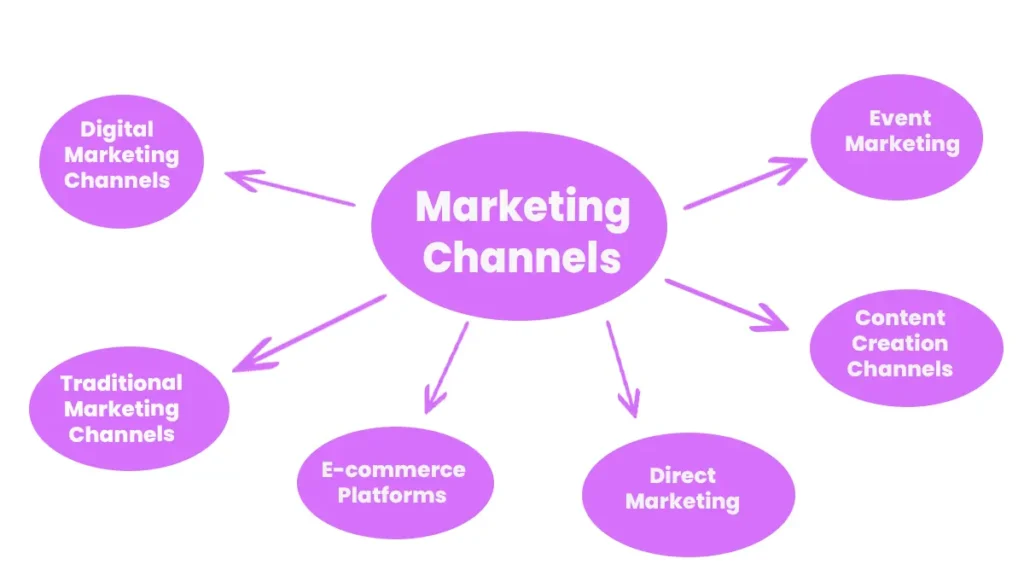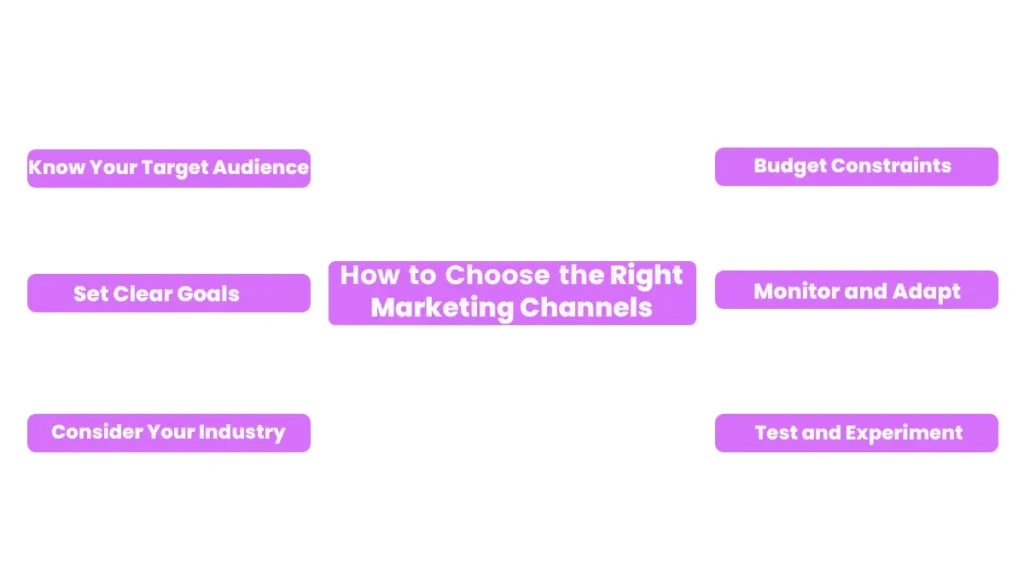Marketing is the lifeblood of any business. It’s how you reach your customers and persuade them to buy your products or services.
There are more marketing channels available than ever before in the fast paced digital world today, making it both exciting and overwhelming for businesses to choose the right ones.
Here we’ll explore the different types of marketing channels, provide a clear definition of marketing channels, and offer guidance on how to select the right channels for your business based on your industry and goals.
What Are Marketing Channels?
Marketing channels, also known as distribution channels, are the avenues through which businesses communicate and deliver their products or services to customers.
These channels serve as bridges that connect producers or sellers with consumers. Essentially, marketing channels are the pathways that enable businesses to reach their target audience effectively.
Marketing channels encompass a wide range of strategies and mediums that businesses use to promote their offerings and engage with potential customers.
These channels can be divided into various categories, each with its unique characteristics and benefits. Let’s delve into some of the most common types of marketing channels.

Types of Marketing Channels

Digital Marketing Channels
Social Media
Social Media Platforms like Facebook, Instagram, Twitter, and LinkedIn allow businesses to engage with their audience through posts, ads, and interactive content.
Email Marketing
Email Marketing Sending targeted emails to a list of subscribers is an effective way to nurture leads and build customer relationships.
Search Engine Marketing (SEM)
Paid advertising on search engines like Google or Bing helps businesses appear prominently in search results.
Content Marketing
Creating valuable and informative content through blogs, videos, and infographics can attract and retain customers.
Affiliate Marketing
Partnering with affiliates or influencers to promote products or services can expand your reach.
Traditional Marketing Channels

Television and Radio
These channels are still relevant for businesses looking to reach a broad audience, especially for mass-market products.
Print Advertising
Magazines, newspapers, and direct mail can be effective for targeting specific demographics.
Outdoor Advertising
Outdoor Advertising refers to Billboards and transit ads provide high visibility in local markets.
E-commerce Platforms
Online Marketplaces
Selling products on platforms like Amazon, eBay, or Etsy can help businesses tap into a large customer base.
Company Websites
Having a user-friendly and informative website is crucial for building trust and driving online sales.
Direct Marketing
Direct Sales
Selling products or services directly to customers through retail stores or company-owned outlets.
Telemarketing
Engaging with potential customers over the phone to promote offerings.
Content Creation Channels
Blogs
Regularly publishing blog posts can establish authority and drive organic traffic.
YouTube
Video content can be a powerful way to demonstrate products or educate customers.
Event Marketing
Trade Shows and Conferences
Participating in industry-specific events can connect businesses with potential partners and customers.
Webinars and Virtual Events
Hosting online events can engage a global audience.
Now that we have a better understanding of the types of marketing channels available, let’s move on to the crucial question of how to choose the right ones for your business.
How to Choose the Right Marketing Channels
Selecting the appropriate marketing channels for your business involves careful consideration of several factors. Keep the following guidelines in mind:

Know Your Target Audience
Understanding your audience’s demographics, preferences, and behaviors is essential.
Different channels resonate with different demographics.
For instance, if your target audience is primarily young adults, social media platforms like Instagram and TikTok may be more effective.
Set Clear Goals
Determine what you want to achieve with your marketing efforts. Are you looking to increase brand awareness, drive sales, or generate leads?
Your goals will influence the choice of channels and the strategies you employ.
Consider Your Industry
Certain industries have specific channels that work best.
For example, a B2B software company might find success through LinkedIn advertising and industry-specific conferences, while a fashion brand may thrive on Instagram and Pinterest.
Budget Constraints
Evaluate your budget and allocate resources accordingly.
Some marketing channels require substantial financial investments, while others can be more cost-effective. It’s important to strike a balance that aligns with your financial capabilities.
Monitor and Adapt
Marketing channels are not static; they evolve over time.
Continuously monitor the performance of your chosen channels and be ready to adapt your strategy if you’re not achieving the desired results.
Test and Experiment
Don’t be afraid to try new channels and strategies.
Conduct A/B tests to determine what works best for your business. Experimentation can lead to valuable insights and improvements.
Marketing Channels for Different Industries
The choice of marketing channels often varies depending on the industry you operate in. Let’s take a look at how different industries can leverage specific channels:
Retail and E-commerce
Online marketplaces, such as Amazon and eBay, are essential for retail businesses.
Social media advertising and email marketing can also be highly effective for promoting products and driving online sales.
B2B (Business-to-Business)
LinkedIn and industry-specific trade shows and events are valuable channels for B2B companies.
Content marketing through blogs and whitepapers can establish expertise and credibility.
Hospitality and Tourism
Travel and tourism businesses benefit from platforms like TripAdvisor, Yelp, and Instagram to showcase their offerings.
Email marketing can help in booking reminders and personalized offers.
Healthcare
Healthcare providers can utilize content marketing through informative blogs and webinars to educate patients.
Social media can be used for community building and sharing health tips.
Real Estate
Real estate agencies often rely on property listing websites, social media, and email marketing to reach potential buyers and renters.
Virtual tours and video content can enhance property listings.
Marketing Channels for Different Business Goals
The choice of marketing channels also depends on the specific goals you aim to achieve:
Brand Awareness
To increase brand visibility, focus on channels that offer broad reach, such as social media, television, and outdoor advertising.
Lead Generation
If your goal is to generate leads, consider using content marketing, email marketing, and pay-per-click (PPC) advertising to capture potential customers’ information.
Sales and Conversions
To drive sales, e-commerce platforms, email marketing, and online marketplaces are effective.
Implement strategies like abandoned cart recovery emails to boost conversion rates.
Customer Engagement and Retention
Maintain customer relationships through channels like social media, email marketing, and loyalty programs that keep customers engaged and returning.
Choosing the right marketing channels for your business involves a thoughtful analysis of your target audience, goals, industry, and available resources.
It’s important to stay adaptable and open to experimenting with new channels as the marketing landscape continues to evolve.
By understanding the types of marketing channels and their respective strengths, you can make informed decisions that will help your business thrive in the competitive world of marketing.
Remember, there’s no one-size-fits-all approach, and finding the right mix of channels is a dynamic process that requires ongoing evaluation and optimization.








